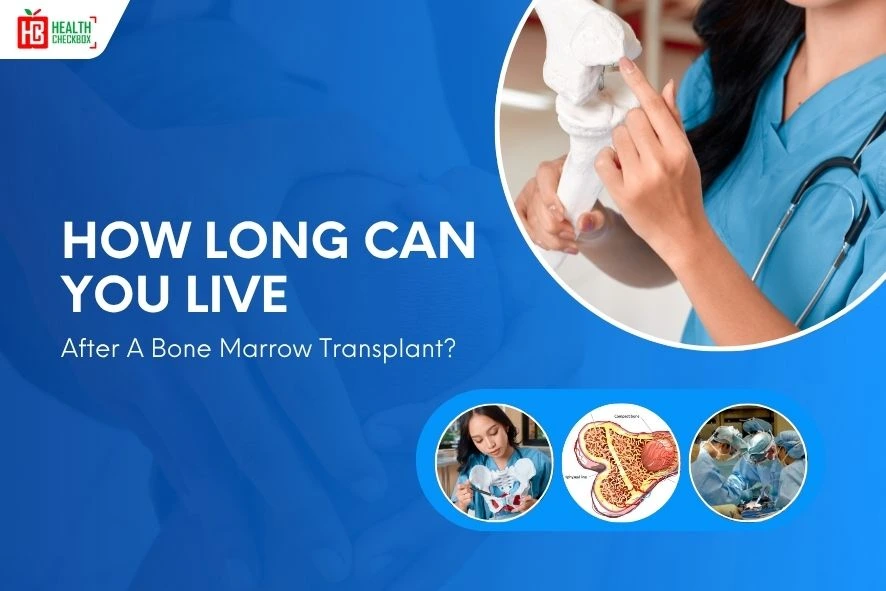A bone marrow transplant saves lives. It involves replacing a patient’s diseased or damaged bone marrow with healthy and working bone marrow. The success of the transplant depends on various factors. These are the types of surgery, general health of the patients, and the presence of any complications. Now in this blog, we will know how long you can live after a bone marrow transplant, its survival rates, and many more.
Due to advancements in medical technology and care, overall survival rates following bone marrow transplants have improved over time. A BMT may be able to cure some patients, and in some circumstances, long-term survival rates can reach 70%.
Others might encounter a number of issues that could affect their quality of life or ability to survive. The way the patient reacts to the transplant continues medical assistance and lifestyle choices.
How Long Can You Live After a Bone Marrow Transplant?
The period of time that a patient can live after the process totally depends on several factors. It includes the type of transplant, the overall health of the patients, and any other health problems. However, many BMT patients who undergo transplant surgery are able to live for 10, 20, or even 30 years or more.
Survival Rates After a BMT or Stem Cell Transplant
The type of transplant and the underlying disease affect the probability of living after a BMT. Below are some general survival rates:
- At least 70% of patients who undergo the successful autologous BMT process survive for at least 2 years.
- 50 – 70% of individuals survive for at least two years after the allogeneic bone marrow transplant.
- In matched sibling donor transplant cases, around 60 – 80% of candidates may survive for at least 2 years after the operation.
- If there is a case of non related donor transplant, then 40 to 60 percent of tolerant people can survive for at most two years.
Factors Affecting Survival Rates
There are several causes that can affect overall survival rate after a BMT operation, including:
- Age: Elderly patients can manage to have lower survival rates than younger patients.
- Disease Condition: Patients with more advanced disease have more chances to lower survival rates than those with less progressive disease.
- Donor Match: Patients who receive a transplant from their family member as a donor. They have higher survival rates than those who receive a transplant from an unconnected donor.
- Graft-Versus-Host Disease: Patients with GVHD have lower survival rates than those who do not develop GVHD.
Common Challenges After Stem Cell or Bone Marrow Transplant
Most of the problems that can happen immediately after the procedure. It occurs due to the usage of medicines or radiation. Some of these adverse effects can be very dangerous if they are not treated on time. It includes:
Throat and Mouth Pain
Inflammation or sores in the mouth are short term side effects. It happens due to chemo or radiation therapy. Treatment improves these types of issues within a few weeks. But in this condition, patients are unable to eat and drink properly.
Vomiting and Nausea
Chemotherapy medications can cause severe problems, and healthcare professionals often give anti-nausea drugs to prevent them. Not any single drug can prevent or control chemo-related nausea and vomiting 100% of the time. Patients should tell their transplant team how well the medicines are controlling their nausea and vomiting.
Infection
Patients can easily get infections around 6 weeks after the procedure, until the new stem cells start making white blood cells. After engraftment, the risk of infection is lower, but it can still happen. It can take six months to a year after transplant for the immune system to work properly.
Bleeding and Transfusions
The conditioning treatment destroys the body’s ability to make platelets, leaving patients at high risk for bleeding after transplant. These platelet counts are low for several weeks after transplant. If the level of platelet count drops, a platelet transfusion may be needed. For this patients should follow some precautions until their platelet counts remain at safe levels.
Acute GVHD
It can occur in 10 to 90 days after the completion of transplantation. Around one-third to one-half of allogeneic transplant recipients will create acute GVHD. Younger patients and those with closer HLA matches between donor and patient are less likely to experience a skin rash, burning, and redness on the palms and soles. Slowly and slowly it can spread over the whole body.
Acute GVHD condition occurs mostly in mild form and mainly affects the skin. But sometimes it can be more serious, or even life-threatening. These mild cases can often be treated with steroid drugs applied on the skin. And serious cases of GVHD might need to be treated with steroid medications taken as a tablet or injected into a vein.
Chronic GVHD
Stem cell transplants can start anywhere from about ninety to six hundred days after the stem cell transplant. A rash on the hands and feet is the early indication. In critical condition, the patient’s skin may swell and peel off, like a bad sunburn. A patient may also suffer from fever. Chronic GVHD is treated with medications that suppress the immune system. Doctors can stop immunosuppressive drugs for patients with chronic GVHD when their symptoms improve.
Discover Post-Transplant Problems
The type of difficulty that can happen after a transplant depends on a large number of factors. The problems can be caused by the conditioning treatment or by other drugs used during the process. Possible long-term risks of transplant include:
- Organ damage
- Relapse of cancer
- Infertility
- Secondary cancer
- Hormone changes
- Vision problems
Conclusion
In this blog, we described all the factors of how long you can live after a bone marrow transplant. A bone marrow transplant is a pivotal surgical procedure that offers hope and healing for individuals. Patients fight with various life-threatening conditions like blood disorders or cancers and get a second chance at life.
The entire procedure can be challenging, but many individuals are able to enjoy a long and healthy life after the transplant. If you or a loved one is considering a BMT, then you should consult with a qualified healthcare professional.

